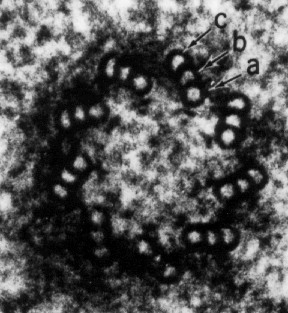centriole

A high magnification electron micrograph showing a centriole in transverse section. Its wall is made up of 9 sets of triplets. Each triplet is composed of 3 subunits: a, b, and c, which form a microtubule.
A centriole is a short cylindrical organelle found in eukaryotic cells, except those of higher plants. Each centriole is composed of cylinders of nine triplet microtubules in a ring. Centrioles occur in pairs arranged at right angles to each other at the center of a microtubule organizing center (MTOC) or centrosome.
A centriole is similar in structure to the basal body found at the base of eukaryotic cilia and flagella and organizes the axoneme, the bundle of microtubules and other proteins forming the core of each cilium or flagellum.


